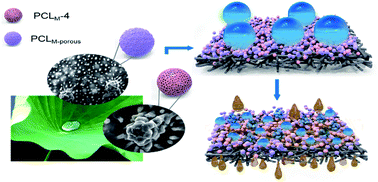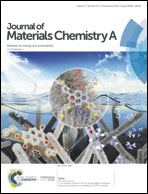Biomimetic preparation of a polycaprolactone membrane with a hierarchical structure as a highly efficient oil–water separator
Abstract
A superhydrophobic, superoleophilic and eco-friendly polycaprolactone composite (PCLC) membrane with a hierarchical microsphere structure was developed by alternated electrospinning/electrospraying technology. The PCLC membrane was subtly designed with two parts to imitate the lotus leaf structure: low surface energy SiO2 nanoparticles on the surface of PCL smooth microspheres (PCLM) imitate the hydrophobic bio-wax of the lotus leaf surface, and PCL porous microspheres (PCLM-porous) imitate the surface nano-protrusions of the lotus leaf. The average size of the potholes on the PCLM-porous surface was only about 300 nm. The combination of small potholes and the hierarchical structure of the PCLC and SiO2 nanoparticles contributed to the superhydrophobicity and superoleophilicity of the PCLC membrane. The water contact angle (WCA) of PCLC could reach 162.0 ± 1.5°. Compared with membranes based on PCLM-porous (WCA = 148.9 ± 1.2°) and 4% SiO2 nanoparticles on PCLM (WCA = 158.6 ± 2.3°), the PCLC membrane not only showed higher superhydrophobicity but also ultra-high oil–water separation efficiency, oil flux and stability. Most importantly, the PCLC membrane exhibited excellent oil adsorption performance for four different oils with different densities, and the separation efficiency remained ultrahigh (>99.93%) even after 10 cycles. This innovative work may provide an effective strategy for the design of biomimetic biopolymers with promising applications in the field of eco-friendly separators.



 Please wait while we load your content...
Please wait while we load your content...